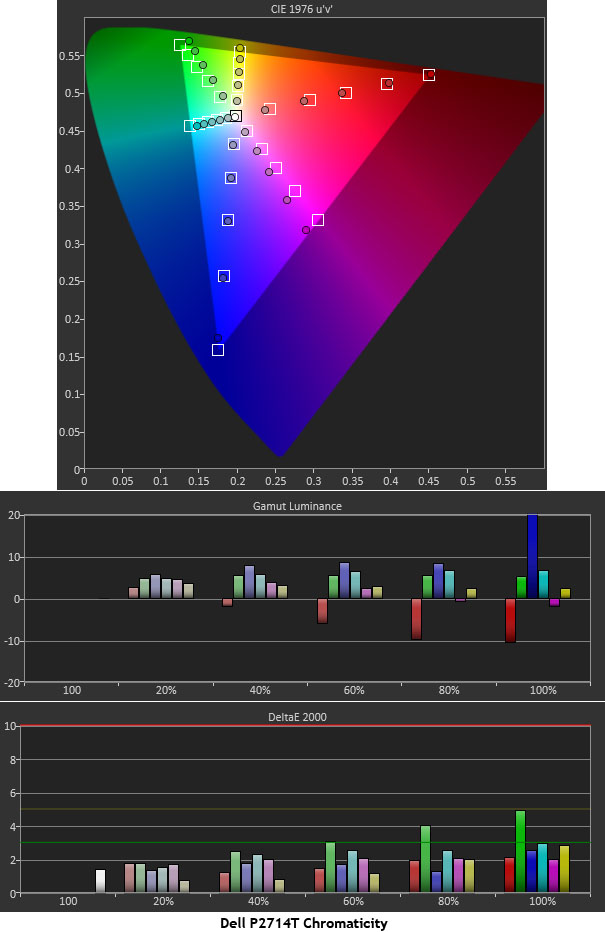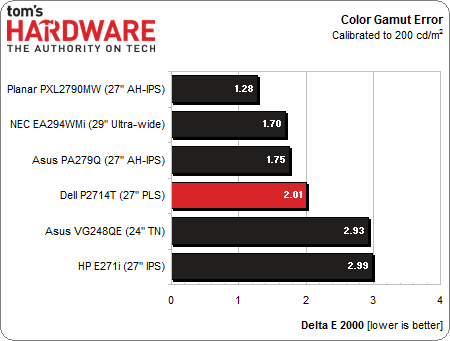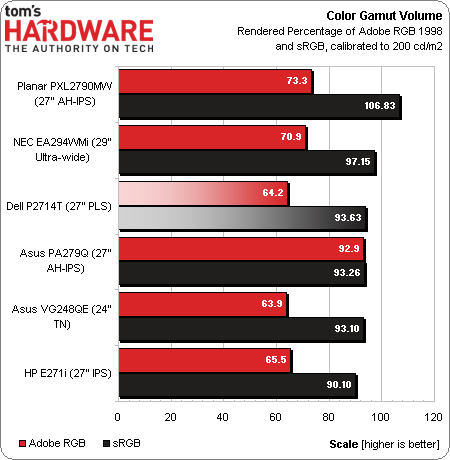Dell P2714T 27-Inch Touchscreen Monitor, Reviewed
If you're looking for the tablet-like experience on your desktop PC, Dell's P2714T could be the answer. This 27-inch multi-touch screen offers FHD resolution and sleek design at a high price point. But does its performance stack up in our lab tests?
Results: Color Gamut And Performance
Color gamut is measured using a saturation sweep that samples the six main colors (red, green, blue, cyan, magenta, and yellow) at five saturation levels (20, 40, 60, 80, and 100%), providing a more realistic view of color accuracy. Since there are no color management controls on the P2714T, we're only showing the post-calibration graphs (although we’re sure they'd look pretty much the same out-of-box).
The CIE chart up top looks pretty good with the exception of green and magenta, which are clocked slightly away from their targets. All of the saturation measurements are close to correct. The luminance levels also approach the standard, with only 100-percent blue rising to a point that’s about 25 percent too bright. Since that color is also a little under-saturated, the extra luminance isn’t a problem. The overall Delta E errors are all invisible except for 80- and 100-percent green, which can barely be seen. The P2714T offers excellent color accuracy.
Let’s see how the P2714T stacks up against the competition.
A total average of 2.01 Delta E is extremely low. You won’t see any color error on the P2714T. Do you need proof that monitors just keep improving? Dell's excellent is a mid-pack result; not only here. but for all of 2013!
Gamut Volume: Adobe RGB 1998
There are basically two categories of displays in use today: those that conform to the sRGB/Rec 709 standard like HDTVs, and wide-gamut panels that show as much as 100 percent of the Adobe RGB 1998 spec. We use Gamutvision to calculate the gamut volume, based on an ICC profile created from actual measurements. The chart shows the percentage of both sRGB and Adobe RGB 1998 gamuts.
This result is pretty typical of the sRGB monitors we’ve tested. Only a slight under-saturation of blue prevents it from being higher. If you don’t need the larger Adobe RGB 1998 gamut, Dell's P2714T is plenty accurate enough for photo editing and pro graphics applications.
Get Tom's Hardware's best news and in-depth reviews, straight to your inbox.
Current page: Results: Color Gamut And Performance
Prev Page Results: Grayscale Tracking And Gamma Response Next Page Results: Viewing Angle And Uniformity
Christian Eberle is a Contributing Editor for Tom's Hardware US. He's a veteran reviewer of A/V equipment, specializing in monitors. Christian began his obsession with tech when he built his first PC in 1991, a 286 running DOS 3.0 at a blazing 12MHz. In 2006, he undertook training from the Imaging Science Foundation in video calibration and testing and thus started a passion for precise imaging that persists to this day. He is also a professional musician with a degree from the New England Conservatory as a classical bassoonist which he used to good effect as a performer with the West Point Army Band from 1987 to 2013. He enjoys watching movies and listening to high-end audio in his custom-built home theater and can be seen riding trails near his home on a race-ready ICE VTX recumbent trike. Christian enjoys the endless summer in Florida where he lives with his wife and Chihuahua and plays with orchestras around the state.
-
killerclick Lol touchscreens on the desktop, it was a crappy idea 2 years ago and it's a crappy idea now.Reply -
damianrobertjones @killerclick: That, of course, is YOUR opinion. I'd rather have the option than not have the option. Maybe we should just stop providing options... ."Having to lift your hand from the keyboard to reach out and touch your monitor definitely takes more time."So does moving your hand from the mouse back to the keyboard. As it stands I do actually prefer having touch.Reply -
damianrobertjones @killerclick: That, of course, is YOUR opinion. I'd rather have the option than not have the option. Maybe we should just stop providing options... ."Having to lift your hand from the keyboard to reach out and touch your monitor definitely takes more time."So does moving your hand from the mouse back to the keyboard. As it stands I do actually prefer having touch.Reply -
therogerwilco Don't talk to me about desktop monitors unless they have better resolutions than 1600p.Reply -
InvalidError @damian: having options may be nice but touch-screen on the desktop for everyday computing and productivity with touch as the primary input sounds like a horrible ergonomic disaster: to use a large touch screen, you need to bring it close to your waist to avoid excessive strain on your arms but putting the display there means having to hold your head at ridiculous angles to look at the screen which is going to strain your neck.So, touch on a large screen only makes sense for occasional/intermittent use.Reply -
killerclick Reply12389025 said:@killerclick: That, of course, is YOUR opinion. I'd rather have the option than not have the option. Maybe we should just stop providing options...
I said it's a crappy idea that's not going to catch on, and I'd prefer not to have to pay extra for it or sacrifice other aspects of the display, like resolution in this case. That said, the companies can put their R&D and marketing $ wherever they want, not my money, but it's still dumb.
-
Patrick Tobin After having used touch extensively on desktop, laptop and tablet form factors I have to say it works really well for a desktop system for quick hits and the such and getting in and out of stuff quickly in Windows 8, on a laptop it makes very little sense though. I would rather have it than not, but not at 1920x1080.Reply -
hannibal The childrens that are now using iDevices and similar can not live with traditional display if there are these in the market. In the long run non touchable monitors are gonna die out. Sooner or later there are more of those touch orientated customer than we old fossilised normal screen users... Eventually we die out and so will normal monitors. For me touch based pad with screen would be ideal for controlling win8 in my desktop. It would be on the table just like my mouse, so I don't have ro rise my hand to do something...In few years there will be a lot of 4K monitors with touch interface, because big audience have to have them...Reply -
Patrick Tobin After having used touch extensively on desktop, laptop and tablet form factors I have to say it works really well for a desktop system for quick hits and the such and getting in and out of stuff quickly in Windows 8, on a laptop it makes very little sense though. I would rather have it than not, but not at 1920x1080.Reply


